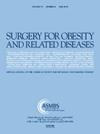Evaluation of gastric content in fasting patient during semaglutide use: an observational study
IF 3.5
3区 医学
Q1 SURGERY
引用次数: 0
Abstract
Background
The evident influence of GLP-1 agonists as semaglutide on gastric emptying even in adherence to recommended fasting protocols instigates debates.
Objective
To investigate the effect of semaglutide on gastric content by gastric ultrasonography in volunteers.
Setting
Private hospital.
Methods
The present study is an observational, cross-sectional, and single-center study. We included 30 consecutive volunteers aged ≥18 years who had undergone a minimum fasting period of 8 hours for solid foods and 2 hours for clear, residue-free liquids. The intervention group consisted of 15 volunteers who had used semaglutide within the last 7 days, whereas the control group consisted of 15 volunteers who had never used semaglutide. The main objective was to determine whether the stomach was full or not.
Results
Between June 2023 and August 2023, a total of 30 adult volunteers were included in the study, and no participant was excluded. The semaglutide group exhibited a higher prevalence of full stomach (11 of 15 [73%] versus 1 of 15 [7%], P < .001; adjusted to age P = .003). The semaglutide group also exhibited a higher prevalence of early satiety (10 of 15 [67%] versus 0 of 15 [0%], P < .001), loss of appetite (10 of 15 [67%] versus 0 of 15 [0%], P < .001), gastric fullness (8 of 15 [53%] versus 0 of 15 [0%], P = .002), and nausea (7 of 15 [47%] versus 1 of 15 [7%], P = .035). Additionally, there is no case in the semaglutide group with no gastric contents.
Conclusions
The use of semaglutide is associated with full stomach even after appropriate overnight fasting. Semaglutide is also associated with increased gastrointestinal symptoms such as loss of appetite, early satiety, gastric fullness, and nausea.
一项观察性研究:评估使用塞马鲁肽期间空腹患者的胃内容物。
背景:GLP-1激动剂如塞马鲁肽对胃排空的明显影响,即使是在遵守推荐的空腹方案的情况下,也会引起争论:通过胃超声波检查志愿者的胃内容物,研究塞马鲁肽对胃内容物的影响:地点:私立医院:本研究是一项观察性、横断面和单中心研究。我们连续纳入了 30 名年龄≥18 岁的志愿者,他们至少禁食 8 小时固体食物,禁食 2 小时无渣透明液体。干预组由 15 名在过去 7 天内使用过塞马鲁肽的志愿者组成,而对照组由 15 名从未使用过塞马鲁肽的志愿者组成。主要目的是确定胃部是否饱满:结果:在 2023 年 6 月至 2023 年 8 月期间,共有 30 名成年志愿者参与了研究,没有人被排除在外。结果表明,塞马鲁肽组的饱腹率更高(15人中有11人[73%],而15人中有1人[7%],P < .001;根据年龄调整后,P = .003)。塞马鲁肽组还表现出更高的早饱率(15 例中有 10 例[67%],15 例中有 0 例[0%],P < .001)、食欲不振率(15 例中有 10 例[67%],15 例中有 0 例[0%],P < .001)、胃部饱胀率(15 例中有 8 例[53%],15 例中有 0 例[0%],P = .002)和恶心率(15 例中有 7 例[47%],15 例中有 1 例[7%],P = .035)。此外,塞马鲁肽组中没有出现无胃内容物的病例:结论:使用塞马鲁肽时,即使适当空腹过夜也会出现饱腹感。结论:即使在适当的隔夜禁食后,使用塞马鲁肽也会导致胃部饱胀。塞马鲁肽还会增加胃肠道症状,如食欲不振、早饱、胃部饱胀和恶心。
本文章由计算机程序翻译,如有差异,请以英文原文为准。
求助全文
约1分钟内获得全文
求助全文
来源期刊
CiteScore
6.70
自引率
12.90%
发文量
570
审稿时长
56 days
期刊介绍:
Surgery for Obesity and Related Diseases (SOARD), The Official Journal of the American Society for Metabolic and Bariatric Surgery (ASMBS) and the Brazilian Society for Bariatric Surgery, is an international journal devoted to the publication of peer-reviewed manuscripts of the highest quality with objective data regarding techniques for the treatment of severe obesity. Articles document the effects of surgically induced weight loss on obesity physiological, psychiatric and social co-morbidities.

 求助内容:
求助内容: 应助结果提醒方式:
应助结果提醒方式:


